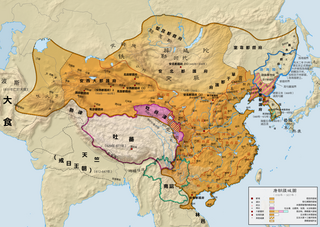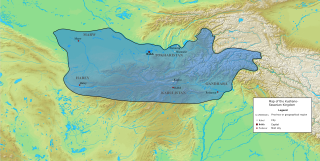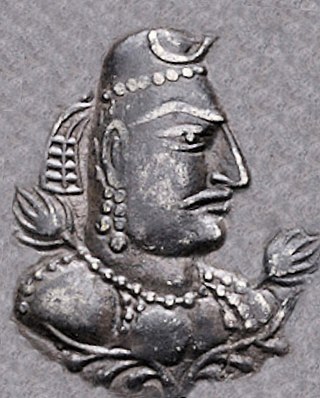The Hephthalites, sometimes called the White Huns, were a people who lived in Central Asia during the 5th to 8th centuries CE, part of the larger group of the Iranian Huns. They formed an empire, the Imperial Hephthalites, and were militarily important from 450 CE, when they defeated the Kidarites, to 560 CE, when combined forces from the First Turkic Khaganate and the Sasanian Empire defeated them. After 560 CE, they established "principalities" in the area of Tokharistan, under the suzerainty of the Western Turks and of the Sasanian Empire, before the Tokhara Yabghus took over in 625.
The Sogdian language was an Eastern Iranian language spoken mainly in the Central Asian region of Sogdia, located in modern-day Uzbekistan, Tajikistan, Kazakhstan and Kyrgyzstan; it was also spoken by some Sogdian immigrant communities in ancient China. Sogdian is one of the most important Middle Iranian languages, along with Bactrian, Khotanese Saka, Middle Persian, and Parthian. It possesses a large literary corpus.
The Kidarites, or Kidara Huns, were a dynasty that ruled Bactria and adjoining parts of Central Asia and South Asia in the 4th and 5th centuries. The Kidarites belonged to a complex of peoples known collectively in India as the Huna, and in Europe as the Chionites, and may even be considered as identical to the Chionites. The 5th century Byzantine historian Priscus called them Kidarite Huns, or "Huns who are Kidarites". The Huna/Xionite tribes are often linked, albeit controversially, to the Huns who invaded Eastern Europe during a similar period. They are entirely different from the Hephthalites, who replaced them about a century later.

Tokharistan is an ancient Early Middle Ages name given to the area which was known as Bactria in Ancient Greek sources.

The Kushano-Sasanian Kingdom was a polity established by the Sasanian Empire in Bactria during the 3rd and 4th centuries. The Sasanian Empire captured the provinces of Sogdia, Bactria and Gandhara from the declining Kushan Empire following a series of wars in 225 CE. The local Sasanian governors then went on to take the title of Kushanshah or "King of the Kushans", and to mint coins. They are sometimes considered as forming a "sub-kingdom" inside the Sasanian Empire.

Chaghaniyan, known as al-Saghaniyan in Arabic sources, was a medieval region and principality located on the right bank of the Oxus River, to the south of Samarkand.

Dilberjin Tepe, also Dilberjin or Delbarjin, is the modern name for the remains of an ancient town in modern (northern) Afghanistan. The town was perhaps founded in the time of the Achaemenid Empire. Under the Kushan Empire it became a major local centre. After the Kushano-Sassanids the town was abandoned.

Central Asian art is visual art created in Central Asia, in areas corresponding to modern Kyrgyzstan, Kazakhstan, Uzbekistan, Turkmenistan, Tajikistan, Afghanistan, and parts of modern Mongolia, China and Russia. The art of ancient and medieval Central Asia reflects the rich history of this vast area, home to a huge variety of peoples, religions and ways of life. The artistic remains of the region show a remarkable combinations of influences that exemplify the multicultural nature of Central Asian society. The Silk Road transmission of art, Scythian art, Greco-Buddhist art, Serindian art and more recently Persianate culture, are all part of this complicated history.

The Principality of Chaghaniyan, known in Arabic sources as al-Saghaniyan, was a part of the Hephthalite Confederation from the 5th to the 7th century CE. After this, it was ruled by a local, presumably Iranian dynasty, which governed the Chaghaniyan region from the late 7th-century to the early 8th-century CE. These rulers were known by their titles of “Chaghan Khudah”.

The Alchon Huns, also known as the Alkhan, Alchono, Alxon, Alkhon, Alakhana, and Walxon, were a nomadic people who established states in Central Asia and South Asia during the 4th and 6th centuries CE. They were first mentioned as being located in Paropamisus, and later expanded south-east, into the Punjab and Central India, as far as Eran and Kausambi. The Alchon invasion of the Indian subcontinent eradicated the Kidarite Huns who had preceded them by about a century, and contributed to the fall of the Gupta Empire, in a sense bringing an end to Classical India.

The term Iranian Huns is sometimes used for a group of different tribes that lived in Central Asia, in the historical regions of Transoxiana, Bactria, Tokharistan, Kabul Valley, and Gandhara, overlapping with the modern-day Afghanistan, Tajikistan, Uzebekistan, Eastern Iran, Pakistan, and Northwest India, between the fourth and seventh centuries. They also threatened the Northeast borders of Sasanian Iran and forced the Shahs to lead many ill-documented campaigns against them.

The Sasanian coinage of Sindh refers to a series of Sasanian-style issues, minted from 325 to 480 CE in Sindh, in the southern part of modern Pakistan, with the coin type of successive Sasanian Empire rulers, from Shapur II to Peroz I. Together with the coinage of the Kushano-Sasanians, these coins are often described as "Indo-Sasanian". They form an important part of Sasanian coinage.

Balalyk tepe, in former Bactria, modern Uzbekistan, is a Central Asian archaeological site with many mural paintings. It was the site of a small fortified manor belonging to a princely Hephthalite clan. It is generally dated a bit later than the painting at Dilberjin, from the late 5th century to the early 7th century CE, or from the end of the 6th century to the early 7th century CE. The paintings of Balalyk Tepe are part of a "Tokharistan school", which also includes Adzhina-tepe and Kafyr-kala. They are succeeded chronologically by the Sogdian art of Penjikent.

Aydogdy Kurbanov is a Turkmen archaeologist and historian whose main area of research is prehistoric and late antiquity of Central Asia.

The Hephthalite silver bowl is a bowl discovered in the Swat region of Gandhara, Pakistan, and now in the British Museum. It dates from 460 to 479 CE, and the images represent two different Huna tribes, suggesting a period of peaceful coexistence between the Kidarites and the Alchons.

The State Museum of Culture History of Uzbekistan is a museum of history and culture in Samarkand.

The murals of Penjikent are among the most famous murals of the pre-Islamic period in Panjakent, ancient Sogdiana, in Tajikistan. Numerous murals were recovered from the site, and many of them are now on display in the Hermitage Museum in Saint Petersburg, and in the National Museum of Antiquities of Tajikistan in Dushanbe. The murals reveal the cosmopolitan nature of the Penjikent society that was mainly composed of Sogdian and Turkic elites and likely other foreign merchant groups of heterogeneous origin. Significant similarities with Old Turkic clothing, weapon items, hairstyles and ritual cups are noted by comparative research.

The Seal of Khingila is an historical seal from the region of Bactria, on southern Central Asia. The seal was published recently by Pierfrancesco Callieri and Nicholas Sims-Williams. It is now in the private collection of Mr. A. Saeedi (London). Kurbanov considers it as a significant Hephthalite seal. It has also been considered as intermediate between the Kidarites and the Hephthalites.

A kulāf, or kolāh, is a type of cap that designated Sasanian nobility and official. It appears on numerous reliefs and seals of the Sasanian Empire period.

The Chilek silver bowl is a silver bowl found in the area of Samarkand, and considered as the "best known specimen of Hephthalite art". More specifically, the bowl seems to belong to the Alchon Huns, south of the Hindu-Kush, during the last third of the 5th century CE. The Alchons have long been considered as a part or a sub-division of the Hephthalites, or as their eastern branch, but now tend to be considered as a separate entity.
























